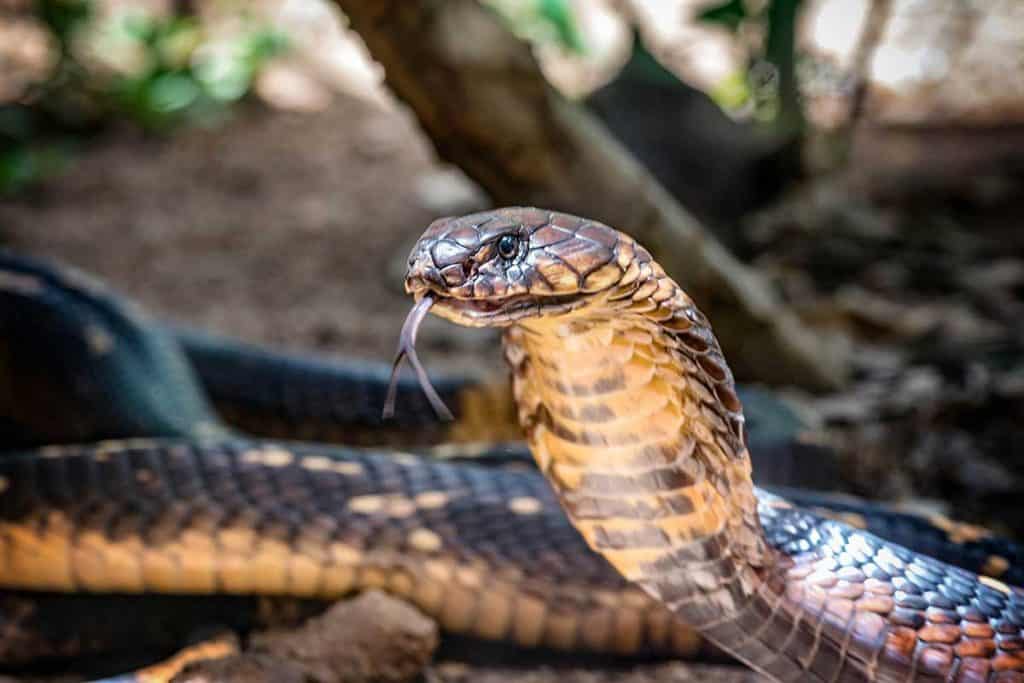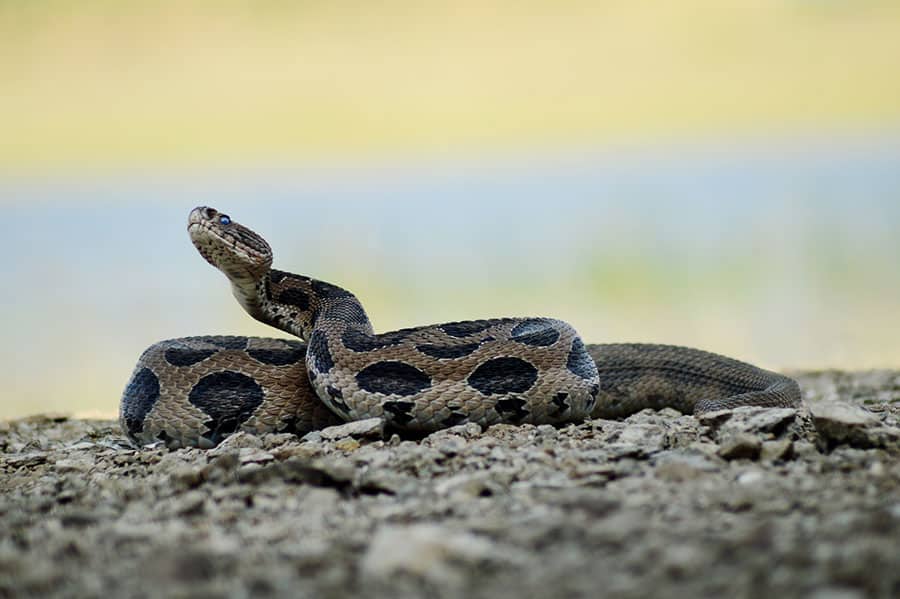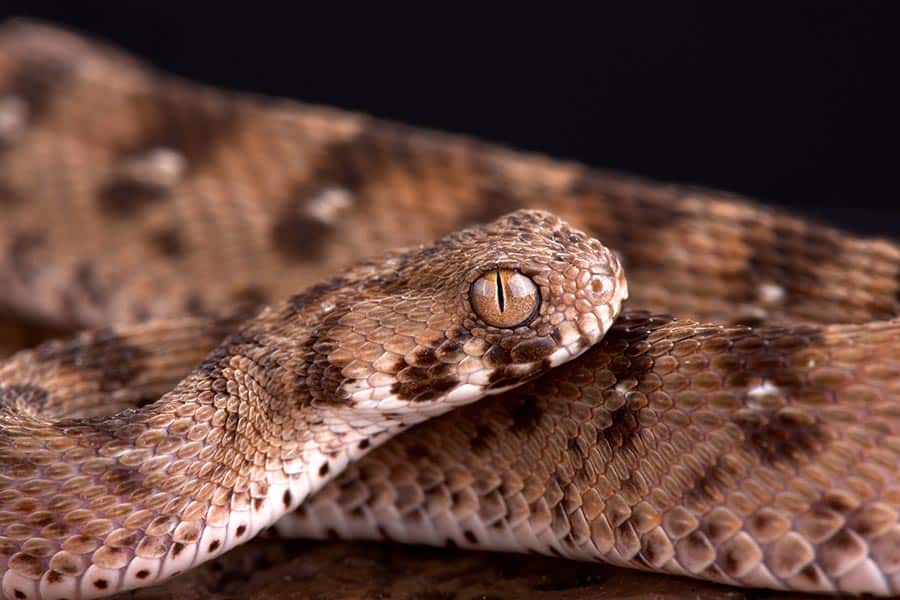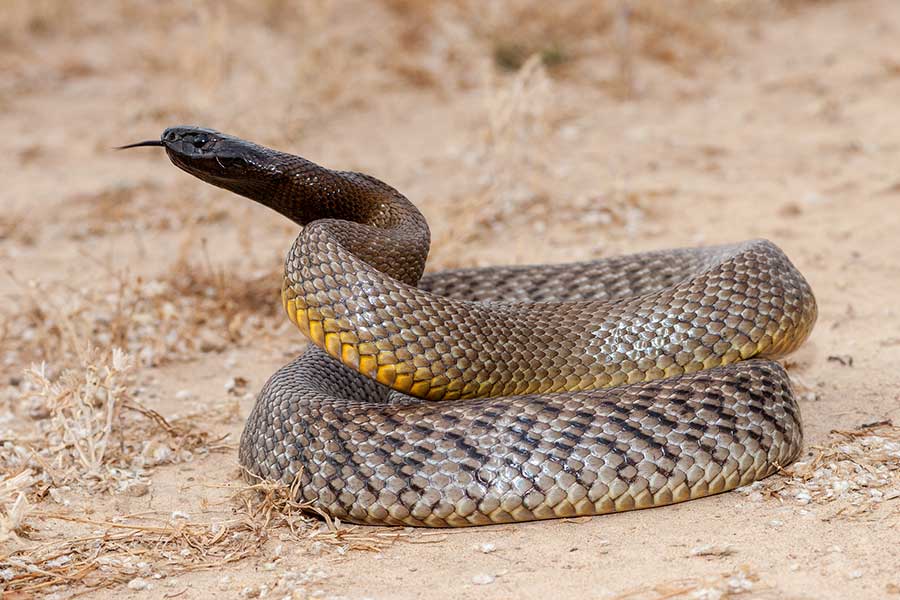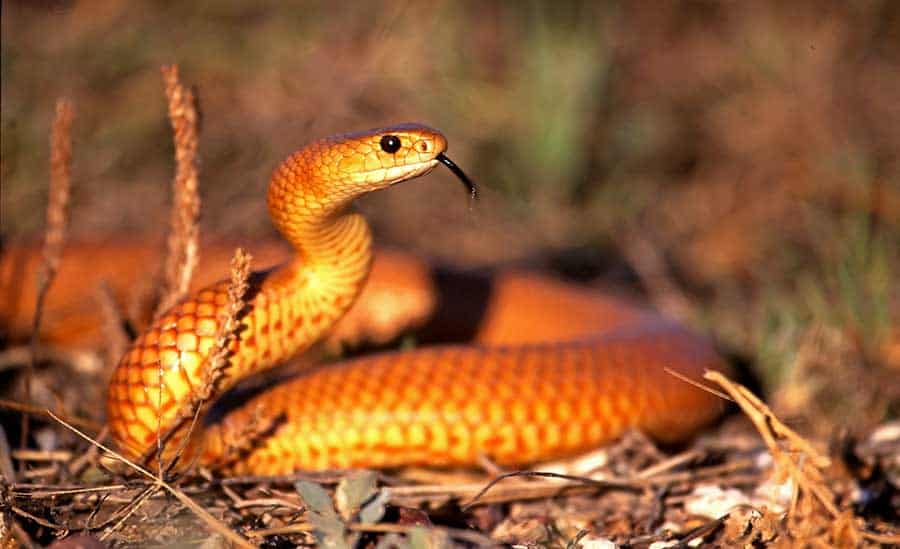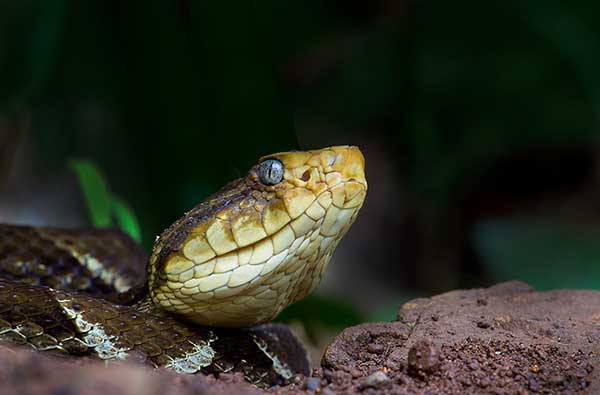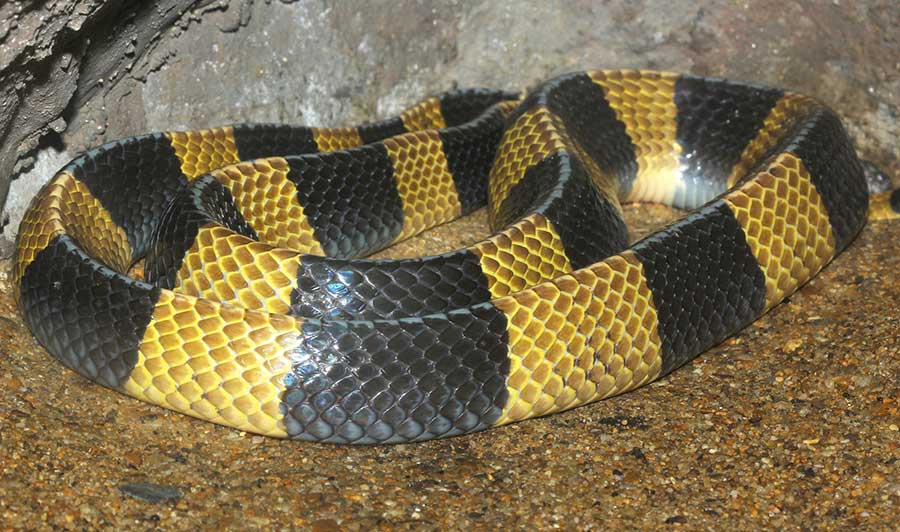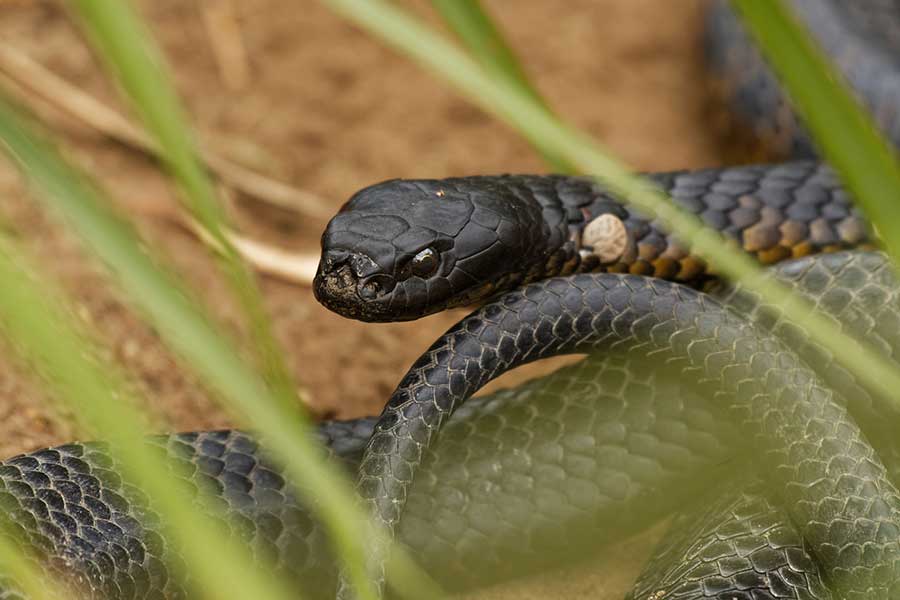Every budding snake enthusiast always wants to know the answer to the question: what is the most venomous snake in the world? It turns out, there are lots of potential candidates with super potent venom! However, venom isn’t the only factor that determines how deadly a snake can be.
To compile this list, each snake was closely examined to determine the lethality of their venom, their overall aggressiveness, their average number of bites per year, and the mortalities they account for. Considering all of these factors, we have come up with a pretty terrifying list of snakes!
It is always good to remember that snakes have evolved to have venom as a method of hunting and survival. Humans are never the intended target of snake venom. After all, that would be a waste of resources for the snake because they cannot eat us!
Before we get into our list, it is important to mention that even if a snake is deadly and kills many people every year (like some of the snakes on this list), they do not deserve to die. They are simply being found in the wrong place at the wrong time due to humans encroaching on their natural habitat.
All of the snakes on this list are considered ‘hot snakes,’ which means their venom can kill, and they should not be owned by hobbyists for obvious reasons. Research facilities that own these snakes do so because they use the venom in research and treating illnesses.
What Is the Most Venomous Snake in the World?
That would have to be the Inland Taipan, with its 0.01 to 0.025 mg/kg median lethal dose (L50) SC and 80% mortality rate. Good thing this species is pretty shy and more likely to run away from a threat rather than wield its venom power. Read more about the inland taipan below.
The Most Dangerous Snake Species
Needless to say, you should avoid keeping any of these as pets. If you are a burgeoning snake enthusiast and want to adopt your very own slithery friend, go for these beginner snakes one of the small snake species!
1. Black Mamba
The black mamba (Dendroaspis polylepis) is primarily native to Eastern Africa, but it can also be found in most parts of Eastern, Sub-Saharan, and Southern Africa. It is the deadliest snake in Africa. Although its venom isn’t the most potent, it has the longest strike range and is the fastest snake on land, and one of the biggest.
Black mambas, despite what their name suggests, are actually a brown to gray color! What really gives them their name is the color of their mouths. Staring into the inky black jaws of a black mamba can feel like staring into the jaws of death itself!
This is a pretty accurate image because the black mamba can kill a person with just two drops of its venom! Its venom is primarily neurotoxic and cardiotoxic. This makes it a deadly combination.
Fortunately, black mambas do not bite many people because, like most snakes, they would rather avoid human company and are happy to live out their lives in termite mounds and wooded areas. However, of the bites that do occur, most are fatal.
Due to the fact that their natural territory is being increasingly encroached on, black mambas are now making their homes in farm houses and rural settlements that place them in direct contact with humans. While they would rather avoid human contact, they are incredibly aggressive when threatened.
The black mamba is the second fastest snake in the world, just behind the sidewinder. Even though it comes in second place, it can reach speeds of up to 12 miles per hour!
In addition to this terrifying speed, the black mamba can move quickly even while holding two-thirds of its 13 foot long body off the floor! Because they are so aggressive, black mambas will readily attack humans when threatened or cornered.
2. Russell’s Viper
The Russell’s viper (Daboia russelii) is native to India and its surrounding areas. This snake is one of the leading causes of snake bite-related deaths, with them being responsible for the majority of the 58,000 snake bite deaths a year in India.
The Russell’s viper mainly makes its home in paddy fields where it can feast on mice, rats, and other small mammals that cross its path. This five-foot-long snake is small and stealthy enough to blend in well with the farmland area.
Due to its ability to camouflage itself so well, many farmers are bitten by accident during harvest season.
Even though most bites are accidental, it does not change the potency of the snake’s venom. The venom of Russell’s vipers is particularly nasty. It is neurotoxic, which leads to multiorgan failure. It also contains a coagulant that turns a bite victim’s blood into thick, viscous jelly inside their veins.
This painful experience can lead to death very quickly if not treated immediately. Unfortunately, there is often lasting damage to organs and the pituitary gland even if a person survives the bite.
3. Saw-Scaled Viper
The saw-scaled viper (Echis carinatus) is native to the Middle East, Northern Africa, Sri Lanka, and India. The stunning orange, brown, and black markings on its body help it to blend in with the arid surroundings of its natural habitat.
This rather small snake averages out at only around two feet in length. This makes it an unimposing snake at a glance even though it is actually incredibly deadly.
When threatened, these snakes quickly let people know they mean business! Their keeled scales rub together when they wind up into an S-shape as they become ready to strike. This rubbing creates a loud hissing sound that is meant to warn off predators.
The saw-scaled viper makes up for its diminutive size by being incredibly aggressive, impulsive, and ready to strike.
Only 10% of all bites end up in fatalities. However, saw scaled vipers bite people so often that their fatalities make up more than all of the other species of snakes in snake bite-related deaths.
Their venom is primarily hemotoxic and cytotoxic. This means it breaks down red blood cells, which quickly causes internal and external bleeding. It also causes cell death on a large scale. These snakes may be small, but they pack a substantial punch!
4. Inland Taipan
The inland taipan (Oxyuranus microlepidotus) is widely considered the most venomous snake in the world.
This is because its venom is a potent mix of procoagulants that can stop blood from clotting, neurotoxins that attack neural pathways and shut down the respiratory system, and myotoxins, which attack the muscles.
The inland taipan’s venom is so unique and deadly that it has its own classification: taipoxin! Along with the deadly cocktail, the venom also has a fast-spreading mechanism (hyaluronidase enzyme) which means it is fast-acting and is absorbed very quickly.
The venom is so lethal that it kills 80% of all untreated victims. This is largely because by the time a bite victim gets to a hospital, their time is up. The taipoxin kills in under an hour!
This fierce snake is native to the Channel Country in eastern Australia. The Aboriginal name for the snake is ‘dandarabilla.’
The inland taipan averages out at six and a half feet in length with very little sexual dimorphism between the males and females.
Even though the venom of the inland taipan is deadly enough to kill a human in under an hour, its usual prey are small rodents like long-haired rats and the common house mouse!
The inland taipan is relatively shy in nature and typically does not seek out human contact. However, if it feels cornered or threatened in any way, it will not hesitate to strike out. If bitten, you’ll be playing a dangerous game of “how quickly can I get to the hospital?”
5. Eastern Brown Snake
The eastern brown snake (Pseudonaja textilis), also known as the common brown snake, is native to Eastern and Central Australia and is far more common than the first snake on this list.
These snakes average out at around five to six feet in length, and even though they are called ‘brown’ snakes, they come in a variety of colors all the way from creamy tan to black.
The eastern brown snake’s venom targets the cardiovascular system. This means it is cardiotoxic and can quickly break down a bite victim’s blood cells. In turn, this causes heart failure, a huge drop in blood pressure which can cause strokes, internal and external bleeding, and eventually death.
In addition to the cardiotoxins, the venom also contains procoagulants that prevent clotting, neurotoxins that shut down the autonomic nervous system, and nephrotoxins that attack the kidneys.
This means even after surviving an eastern brown snake bite you can be left with serious long-term conditions, such as kidney failure and heart problems.
Even though the brown snake’s venom is not as powerful as the inland taipan’s, the eastern brown snake comes into contact with humans far more frequently, which results in people trying to get rid of the snake or accidentally stumbling across it in their homes.
These snakes eat mice and rats in the wild and are found frequently in farmhouses, barns, and in rural settlements, which puts the snake and humans both at risk of being hurt and dying.
Interestingly, the bite itself is relatively painless, and many people do not notice they have been bitten until they start suffering from the envenomation’s effects. This snake holds the unfortunate statistic of causing 60% of all snake bite-related fatalities in Australia.
6. Fer-de-Lance
The Fer-de-Lance (Bothrops atrox) is also known as the barba amarilla and the common lancehead. This snake is a pit viper and comes from tropical areas in Central and South America and parts of Asia.
At only five feet long, this snake makes up for what it lacks in length in its incredible speed and unpredictable movements.
The barba amarilla spends much of its time blending in with the jungle floor and leaf litter and then exploding into action when prey comes near. Usual prey items include rodents, fallen bats, and other small mammals.
Thanks to this snake’s ability to blend in so well with its surroundings, many people stumble upon the common lancehead by mistake and provoke a defense strike. These snakes are very irritable and will strike out if disturbed.
If provoked, this viper is capable of launching its body off the ground and raising its head to a substantial height. This makes it a dangerous snake because even if you think you are out of range, the snake can change that range very quickly and bite your ankle, leg, or even part of your hip and torso region depending on your height.
Unlike the eastern brown snake’s bite, there is no mistaking a Fer-de-Lance bite.
A Fer-de-Lance bite is excruciatingly painful. The pain moves swiftly throughout the area of the bite and into the body. Notably, the venom is necrotizing. This means it causes rapid cell death that spreads from the bite area to other parts of the body.
This snake’s venom is extremely fast-acting, meaning without urgent medical intervention, a bite victim’s death is likely. The barba amarilla definitely deserves its place on this list.
7. King Cobra
The king cobra (Ophiophagus hannah) is native to India, Southeast Asia, the Philippines, and Indonesia. This wide natural range puts the king cobra into close proximity with humans often, which leads to many unfortunate bites.
This deadly snake is also the longest venomous snake in the world, averaging out at 15 feet and weighing in at 20 pounds! This massive snake can hold two-thirds of its body upright, look a six-foot man straight in the eye, and still move forward to attack!
Luckily, this nightmarish snake is relatively shy and does its best to avoid human contact.
The king cobra is most well-known for being the snake of choice for snake charmers. Sadly, though, there is no “charm” going on in this exploitative and cruel practice. The snakes that are used in these shows are typically exhausted, starved, sluggish, kept in poor conditions, regularly milked of their venom, and conditioned through pain to not strike their handlers.
The venom of the king cobra is not as complex as the inland taipan’s or the eastern brown snake’s. However, the quantity of venom that can be delivered in a single bite is enormous at around one fifth of a single fluid ounce! There’s actually enough neurotoxin in a single bite to kill 20 full-grown men or a single Asian elephant.
The neurotoxic venom attacks the nervous system and targets areas in the brain that control breathing and heartbeat. Once these areas of the brain are attacked, it becomes increasingly difficult to breathe as heart failure sets in.
King cobra bites result in a 50% fatality if left untreated.
8. Banded Krait
The banded krait (Bungarus fasciatus) is native to India and Southeast Asia. Averaging at eight feet in length, this strikingly beautiful snake is also incredibly deadly!
True to its name, the banded krait has alternating bands of black and yellow down its body. However, that is not the most striking physical aspect of this snake. The snake’s spine appears to be raised, giving it a pyramid shape along its vertebrae.
Banded kraits are shy snakes and prefer to hide rather than attack. Unfortunately, due to humans encroaching on their territory, they have given up their usual grassy nests for pipes and drains. This brings them into close proximity with humans.
In many cases, humans will then try to kill or remove the snake from their homes without being aware of the gamble they are making on being bitten or not.
Even though they have a more reserved nature than most other snakes on this list, they earn their spot because of the potency of their venom. When they do bite a human, it is a terrifying experience.
If left untreated, the snake’s neurotoxic venom attacks the part of the brain that controls the respiratory system and slowly shuts it down. This means the person bitten by the banded krait will slowly feel themselves starting to suffocate.
9. Tiger Snake
Tiger snakes (Notechis scutatus) are native to Southern Australia, the surrounding islands, and Tasmania. These snakes are very large and are very distinct in both their coloration and size. Their common name is fitting, as their scales are typically banded in alternating colors of black and brown or cream.
These snakes range in average size from three to six feet in length depending on the region in which they live. Notably, there are a couple of subspecies that can vary widely in appearance, but they are all classified as tiger snakes.
Because they are so incredibly well-adapted to live in whatever environment they find themselves in, tiger snakes are very hardy and have a fairly wide geographic range. They can live in marshy areas with high humidity, grassy farmlands, wooded areas, and even more urban human settlements.
The tiger snake’s natural diet includes a wide range of foods it can easily find in its varying native environments, such as fish, frogs, small mammals like rats, birds, other snakes, bats, and even carrion.
Even though humans are not on the menu, when tiger snakes and humans come in contact with one another, it is a stressful experience for both parties.
When threatened or startled, the tiger snake will curl up its body, inflating and deflating itself repeatedly while hissing very loudly. If this display does not warn the offending human off, they will launch an attack and deliver a painful bite.
The tiger snake’s bite contains a very powerful neurotoxin as well as a coagulant. The neurotoxin attacks and shuts down the nervous system. Meanwhile, the coagulant forces the blood to start clotting, turning it from liquid to jelly in the person’s veins.
This terrifying experience will prove fatal if the bite victim does not get medical assistance immediately.
10. Boomslang
Boomslang (Dispholidus typus) is the Afrikaans name for this Sub-Saharan arboreal snake. The Afrikaans word ‘boom’ (b-oo-wuh-m) means ‘tree’ and ‘slang’ (sl-ah-ng) means ‘snake.’ The name is an apt one because the boomslang spends most of its life in the branches of trees.
This snake ranges from vivid green to twig brown in color and has an incredibly slim body, which means it blends into its surroundings incredibly well. These snakes are thin with small heads and enormous eyes with round pupils.
The boomslang is able to camouflage itself well by securing the lower half of its 5-foot-long body around a tree branch and dangling the top half of its body off the branch. The snake can then hold perfectly still or even match the swaying of the branches around it.
This clever ability makes it an exceptional arboreal ambush killer. Its regular prey items include mice, birds, other small snakes, other boomslangs, lizards, chameleons, frogs, various animals’ eggs, and bats.
In fact, this snake is often so well hidden and primed for action that it can even catch birds mid-flight. However, this also means people often do not see the snake and will walk by and brush up against it, thus prompting a defensive strike.
The boomslang is a rear-fanged snake; however, they can open their jaws an impressive 170 degrees! This means they are capable of biting humans even though they are a relatively small type of snake.
The boomslang’s bite can seem harmless, coming from a small snake that mostly snacks on lizards, but its hemotoxic venom is incredibly dangerous. The venom actually breaks down red blood cells. This, in turn, causes massive internal and external bleeding, which can lead to death.
FAQs About Snake Venom
What is the difference between poison and venom?
The difference between poison and venom comes down to the way it is delivered. Venom is typically injected by an animal via fangs, barbs, or stingers. Poisonous animals must be eaten or touched to deliver their poison; they don’t have any means to inject or expel it themselves.
Delicately put:
- If you bite (or eat or touch) it and you die, it was poisonous
- If it bites you and you die, it was venomous
Therefore, snakes can be venomous but not poisonous because they inflict damage and deliver their poison via a bite. However, plants can be poisonous because they affect you only after you have eaten or touched them.
Are baby snakes more or less dangerous than adult snakes?
You would think that, due to their small size, baby snakes are less dangerous than older or larger snakes, right?
It is actually the opposite! Venomous snakes are born with venom glands that are completely full. Adult snakes have the ability to judge how much venom they need to offload in a single bite. They are even able to deliver ‘dry’ bites where there is no envenomation at all.
Baby snakes, on the other hand, are completely unable to judge this and will unload their full dose of venom in a single bite. This makes them far more deadly than their older counterparts.
Hissing and Striking Fear
Many snakes have the ability to kill humans through their venom. The most venomous snake in the world, the inland taipan, kills 80% of all people it bites who do not get immediate treatment.
Even though many of these statistics are terrifying and can make snakes seem very dangerous to keep around, they actually play an important part in many ecosystems. Sadly, the only reason people get bitten so often is because we have encroached into their territory, and they are just trying to survive.

